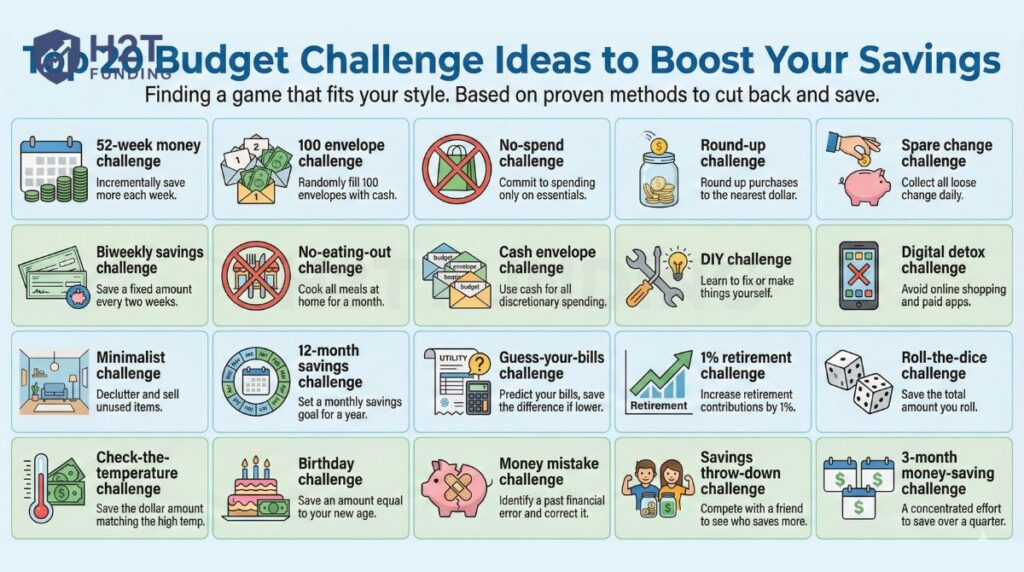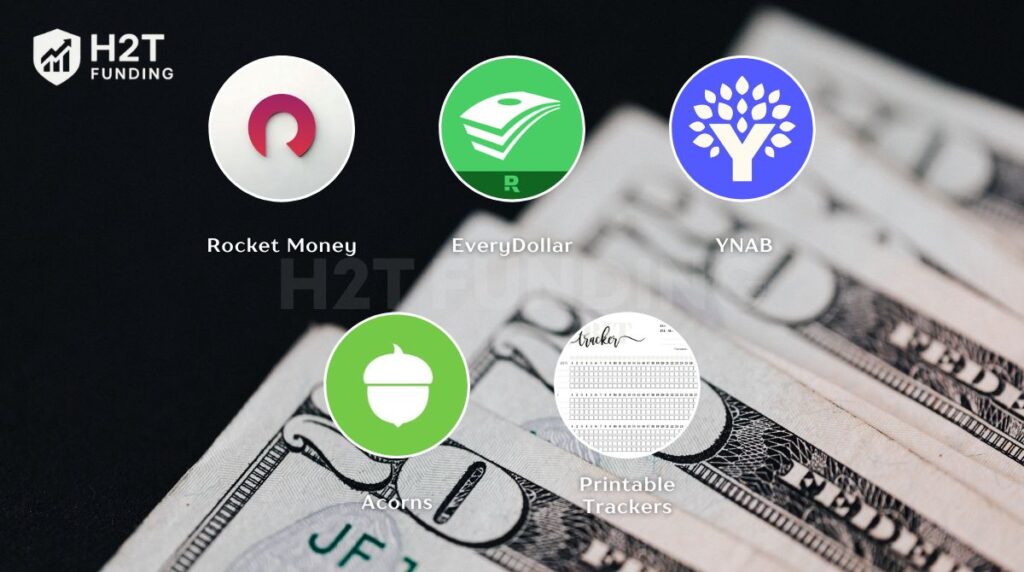For a long time, saving money just never stuck with me. A budget challenge, a savings game with a clear goal and simple rules, was the only thing that finally changed that.
Instead of a complicated budget, a challenge gives you one simple mission to focus on. I tried dozens of different budget challenge ideas, and while some were pointless, a few of them finally made saving feel manageable.
This guide is a collection of the 20 methods that actually work. You don’t need to do them all; picking just one can help you put $500 back in your pocket this month and finally feel in control of your money.
Key takeaways
- A budget challenge is a simple, rule-based savings game that turns the intention to save money into a clear and actionable plan.
- Choosing the right budget challenge idea depends on your lifestyle, income stability, and personal motivation style.
- Popular budget challenges include the 52-week money challenge, 100-envelope challenge, no-spend challenge, round-up challenge, biweekly savings challenge, and no-eating-out challenge.
- Small, consistent actions, such as weekly, biweekly, or automatic savings, can lead to significant financial progress over time.
- Budget challenges help build long-term saving habits, reduce impulse spending, and increase awareness of cash flow.
- Using tools, apps (like Acorns, EveryDollar, Rocket Money), or visual trackers makes budget challenges easier to manage and improves consistency and results.
1. What is a budget challenge?
A budget challenge is a savings game with one clear mission that hits a specific financial target using a simple set of rules. It’s the tool that turns the vague intention of saving more into a concrete, actionable plan.

For the longest time, my problem wasn’t that I didn’t want to save; it was that traditional budgeting felt like a chore. A challenge provided a finish line and made it exciting.
This is the secret to how to make budget challenge work: finding the right game for you. That’s why having a list of different budget challenge ideas is so crucial; the perfect plan is the one you’ll actually stick with.
When you find the right fit, the benefits go far beyond just the money you save:
- Building saving habits: It becomes second nature, not something you have to force yourself to do.
- Reducing impulse spending: That daily coffee doesn’t seem as appealing when you’re close to winning your weekly goal.
- Achieving financial goals: You see real, measurable progress toward that vacation or emergency fund.
A pro-tip that made this effortless for me was to automate savings. It takes willpower out of the equation and guarantees you stay on track.
So, this is the why behind the challenge. Now, let’s find the perfect how for you in the list below.
Find more related articles:
2. Top 20 budget challenge ideas to boost your savings
Alright, let’s get to the good stuff, the challenges themselves.
It turns out most of us are in the same boat right now. A recent Bank of America found that nearly two-thirds (64%) of people are actively trying to cut back, so you are definitely not alone in this.
The key is finding a game that fits your style. To help you do that, I’ve broken down the best savings challenge ideas I’ve personally tried and seen work, from classics to creative new methods:
- The 52-week money challenge
- The 100 envelope challenge
- The no-spend challenge
- The round-up challenge
- The spare change challenge
- The biweekly savings challenge
- The no-eating-out challenge
- The cash envelope challenge
- The DIY challenge
- The digital detox challenge
- The minimalist challenge
- The 12-month savings challenge
- The guess-your-bills challenge
- The 1% retirement challenge
- The roll-the-dice challenge
- The check-the-temperature challenge
- The birthday challenge
- The money mistake challenge
- The savings throw-down challenge
- The 3-month money-saving challenge

Each one has its own rules and rewards. Let’s find the perfect money challenge ideas for you.
2.1. 52-week money challenge
The 52-week money-saving challenge is a year-long plan for building a savings habit without the initial shock. You start by saving a tiny amount and just add a little more each week, which makes it much easier to actually stick with.
How it works:
- Week 1: Save $1.
- Week 2: Save $2.
- …and so on, adding a dollar each week.
- By the end of the year, you’ll have saved $1,378.
To make it stick, I recommend a few simple tricks. My top tip is to automate transfers so you never forget. You can also use a monthly budget planner printable to get that satisfying feeling of checking off each month. A great pro-tip: reverse the order if you know the holidays are a tight time for you.
- Pros: It’s one of the best ways to build a savings habit from scratch.
- Cons: It gets expensive toward the end of the year, and it can be tough to remember which week you’re on without a system.
Who it’s best for: This challenge is ideal for beginners who want a structured plan to build a powerful saving habit over the long haul.
2.2. 100-envelope challenge
The 100 envelope challenge is an exciting and visual way to save a large sum by randomly choosing envelopes and saving the amount written on each. It’s a fun blend of budgeting and surprise.
How it works:
- Label 100 envelopes with numbers from 1 to 100.
- Shuffle them and draw one or two envelopes each week.
- Save the amount shown (e.g., envelope #73 = save $73).
- When all envelopes are completed, you’ll have $5,050 saved.
That flexibility is the key to making this challenge work for you. You can set a slower pace by choosing 2 envelopes/ week to finish in about a year, or adjust the numbers to fit your budget (e.g., 1–50 or 1–100). And if you rarely use cash, you can easily find a digital version to use on your phone.
- Pros: The element of surprise makes saving genuinely fun, and it leads to a massive payoff.
- Cons: The randomness can be a budget-buster. Pulling a high number on a tight week can feel impossible.
To keep track, you can find a $5,000 savings challenge printable PDF free online. It’s a great way to visualize your progress.
Who it’s best for: Anyone motivated by tangible goals and a bit of gamification. It’s especially effective for people who still use cash.
2.3. No-spend challenge
The no-spend challenge forces you to confront your spending habits head-on, especially the ones driven by boredom or impulse. This challenge can honestly change your relationship with money in just a few days.
How it works:
- First, you have to define your absolute essentials. For me, that’s rent, groceries, gas, and bills.
- Then, you pick your timeframe. A weekend is a great way to start, but a full week is even better.
- For that period, you spend money only on that list. No coffee runs, no takeout, no just looking on Amazon.
So much of our spending is mindless. A recent Bankrate study in 2023 found that nearly half of us make impulse buys from social media that we later regret. This challenge is the best way I know to break that pattern and is a huge step in learning how to stop overspending. To survive, you have to lean on free stuff, like organizing a closet, going for a long walk, or having a movie night.
- Pros: It provides a rapid cash boost and instantly highlights your impulse spending triggers.
- Cons: Highly restrictive and not sustainable for long-term budget.
Who it’s best for: Anyone who feels their spending is on autopilot and needs a hard reset to regain control.
2.4. Round-up challenge
The round-up challenge turns everyday purchases into savings opportunities by rounding each transaction up to the nearest dollar and saving the difference. For instance, if you buy coffee for $2.45, the remaining $0.55 gets set aside automatically or manually.
How it works:
- Link your debit or credit card to a round-up app or feature.
- Every time you make a purchase, the app rounds it up to the nearest dollar.
- The difference (e.g., $0.55 from a $2.45 coffee) is automatically transferred to your savings.
Tips: Using the best budgeting apps like Acorns and Chime has made this challenge extremely simple. A 2023 Acorns report shows that users save an average of $30 to $50 per month just by rounding up spare change.
- Pros: It’s completely passive and effortless, making it perfect for building savings in the background.
- Cons: The savings accumulate slowly, so it’s not ideal for aggressive, short-term goals.
Who it’s best for: Individuals who want to save passively without feeling the impact on their daily budget.
2.5. Spare change challenge
The spare change challenge is an old-school but effective method: collect every coin or low-denomination bill left in your wallet or pocket at the end of the day. Store it in a jar, box, or designated container.
How it works:
- At the end of the day, empty all the coins from your wallet or pockets.
- Put them into a dedicated jar, box, or container.
- Once the jar is full, deposit it into your bank account.
The real magic is seeing a pile of forgotten coins turn into a significant amount of money. A popular variation in the UK is the £1 saving challenge, where you save every £1 coin you receive.
- Pros: It’s incredibly simple, and turning physical change into a visible pile is highly motivating.
- Cons: Only effective for people who regularly use cash.
If you’re mostly cashless, you can create a digital version by manually transferring small, odd amounts ($1.35, $0.80, etc.) to your savings every few days.
Who it’s best for: People who frequently use cash and love a tangible, visual savings goal.
2.6. Biweekly savings challenge
The biweekly savings challenge encourages you to save a fixed amount from each paycheck. Since many people are paid every two weeks, this method aligns with common pay schedules.
How it works:
- Decide on a fixed amount to save from each paycheck (e.g., $25, $50, $100).
- The day your paycheck hits, that amount is automatically transferred to a separate savings account.
- That’s it. You pay yourself first, every single time.
Similarly, for the biweekly challenge, the key was automation. I set up a $50 transfer to a separate savings account for the day after my paycheck hit. The trick was moving the money before my brain had a chance to miss it. A year of that, and I had $1,300 plus interest. It’s the easiest win you’ll ever get.
- Pros: It’s consistent and predictable, making it easy to build significant savings over time.
- Cons: It requires discipline to set up the automation and not touch the money.
Tip: Set up automatic transfers to a dedicated savings account to stay consistent without manual effort.
Who it’s best for: Ideal for anyone who is a salaried or hourly worker. Also, flexible enough for freelancers or gig workers who can adapt the amount based on fluctuating income
This method is one of the most effective ways to learn how to stop living paycheck to paycheck.
2.7. No-eating-out challenge
The no-eating-out challenge targets one of the biggest budget-killers for most people. This is a month-long commitment to cooking all your meals at home: no restaurants, takeout, or delivery.
It’s a powerful way to see just how much you can save when you focus on one specific spending category.
How it works:
- For one full month, you commit to preparing 100% of your meals.
- Track the money you would have spent on dining out.
- At the end of the month, transfer that entire amount into your savings.
Success comes from planning. Meal planning for the entire week, get creative with pantry staples, and prepare freezer-friendly meals to avoid last-minute temptations.
- Pros: It can lead to shockingly high savings in a short amount of time.
- Cons: Need significant time for planning, shopping, and cooking.
This challenge is a crash course in how to save money on groceries, as you’ll become much more mindful of your food budget.
Who it’s best for: Anyone who knows dining out is their financial weak spot and is ready for a month of focused effort.
2.8. Cash envelope challenge
The cash envelope challenge brings your budget into the physical world. This forces you to be mindful of your spending by using a set amount of cash for different budget categories, like groceries, gas, or entertainment. Once the cash is gone, spending in that category is paused until the next refill.
How it works:
- At the start of the month, you pull out cash for your variable spending, think groceries, gas, and fun money.
- You physically stuff that cash into envelopes with those labels written on the front.
- Then, you only spend from the correct envelope. When it’s empty, you stop spending in that category until next month.
There’s just something about physically seeing the money leave your hands that makes you a smarter spender. It’s a lot harder to justify a small impulse buy when you have to break a $20 bill for it.
- Pros: It’s incredibly effective at curbing overspending and promoting discipline.
- Cons: Not ideal for online purchases and requires you to carry cash.
To help you get started, you can find a savings challenge printable PDF free download online to use as tracker for your envelopes.
Who it’s best for: People who struggle with overspending on debit or credit cards and need a firm, visual limit.
2.9. DIY challenge
The DIY challenge encourages you to handle tasks yourself rather than pay for a product or service. This could include making homemade meals, gifts, decorations, or even handling basic home repairs.
How it works:
- Identify an area where you typically spend money (e.g., coffee, gifts, home decor).
- For a set period, commit to doing or making it yourself instead.
- Transfer the money you would have spent directly into your savings account.
Think about making homemade gifts, cooking a meal you’d normally order, or tackling a minor home repair with an online tutorial.
- Pros: It saves money while teaching you valuable new skills.
- Cons: It requires a significant time investment and has a learning curve.
The satisfaction of completing a project yourself is a huge motivator, and the skills you learn often lead to long-term savings.
Who it’s best for: Creative individuals who enjoy hands-on projects and are willing to invest time to save money.
2.10. Digital detox challenge
The digital detox challenge asks you to cut back or eliminate spending on digital services for a set period, such as a month. It helps you become more intentional about where your money goes.
How it works:
- Review your recurring digital expenses (streaming, gaming, music subscriptions).
- Cancel or pause any services you’re not actively using.
- Avoid in-app purchases and resist online shopping temptations.
- Redirect the money you would have spent into your savings.
These automatic digital expenses are easy to forget. Stepping back for a month forces you to become more intentional about where your money is going online.
- Pros: It shines a light on subscription creep and provides a surprisingly quick savings boost.
- Cons: Inconvenient and requires discipline to resist online shopping temptations.
Who it’s best for: Anyone who suspects their subscriptions and online habits are costing them more than they realize.
2.11. Minimalist challenge
The minimalist challenge is a powerful way to reset your relationship with stuff. It encourages you to live with less by decluttering what you have and resisting new purchases for a set time.
This challenge is less about what you can’t have and more about appreciating what you already own.
How it works:
- Commit to a no new purchases rule for a set period (e.g., one month).
- Each week, declutter one area of your home, sorting items to donate, sell, or recycle.
- If you feel the urge to buy something, add it to a 30-day want list to avoid impulse buys.
According to The Minimalists podcast and blog, the average American household has over 300,000 items. Selling things you no longer need is a great way to boost your savings while simplifying your space.
- Pros: It drastically reduces spending, decreases clutter, and can improve mental clarity.
- Cons: It requires a significant mental shift away from consumer habits.
Who it’s best for: Individuals feeling overwhelmed by clutter who want to curb their shopping habits and save money simultaneously.
2.12. 12-month savings challenge
The 12-month savings challenge is a long-term commitment to set aside money every month for a full year. You can either save a fixed amount or gradually increase the total each month.
How it works:
- Save $100 every month to reach $1,200 in a year.
- Or start with $10 in January and increase by $10 monthly, ending with $120 in December for a total of $780.
This one is tailor-made for those big-ticket items: a vacation, holiday shopping, or a down payment.
- Pros: The consistency and predictability make it ideal for achieving large, specific financial goals.
- Cons: It lacks the daily fun of other challenges and requires long-term discipline.
My advice? Automate the monthly transfer. Set it up once, and let it do its thing in the background.
Who it’s best for: Someone with a clear, long-term goal who just wants a simple plan that works.
2.13. The guess-your-bills challenge
The guess-your-bills challenge is a clever way to gamify your regular expenses. It turns paying utilities into a monthly competition against yourself.
How it works:
- Right before a bill is due (like electricity or water), write down your guess for the total.
- When the actual bill arrives, compare the numbers.
- If the bill is lower than your guess, you immediately transfer the difference to savings.
It’s a surprisingly fun method that adds a little excitement to an otherwise boring task.
- Pros: It’s a low-effort way to save extra cash and encourages you to be more mindful of your usage.
- Cons: The savings can be unpredictable and are often small.
Who it’s best for: Homeowners or anyone who manages variable monthly bills and enjoys a small, consistent game.
2.14. The 1% Retirement Challenge
The 1% retirement challenge is a small move with a massive long-term impact. It’s less about immediate savings and more about securing your future.
How it works:
- Log in to your 401(k) or other retirement account.
- Increase your contribution rate by just 1%.
- That’s it. You’ll likely never even notice the difference in your paycheck.
This is a one-time action that pays off for years. Setting up these automatic contributions is one of the smartest financial moves you can make.
- Pros: It’s an incredibly powerful way to boost your retirement savings over decades with almost no noticeable impact on your current budget.
- Cons: It doesn’t provide any immediate cash for short-term goals.
Who it’s best for: Everyone with a retirement account. Seriously, it’s one of the smartest financial moves you can make.
2.15. The roll-the-dice challenge
The roll-the-dice challenge adds a fun, unpredictable element to your savings routine. It lets chance decide your savings for the week.
How it works:
- Once a week, find a pair of dice and roll them.
- The total number you roll is the dollar amount you transfer to savings.
- (e.g., rolling a 5 and a 2 means you save $7 that week).
It’s a great way to add a bit of excitement to your financial routine if you’re getting bored.
- Pros: It’s fun, fast, and adds a bit of excitement to your financial routine.
- Cons: The savings are random and won’t add up to a huge amount quickly.
Who it’s best for: People who get bored easily and need a bit of gamification to stay motivated.
2.16. The check-the-temperature challenge
The check-the-temperature challenge is a quirky and passive way to save a little bit every day. It ties your savings directly to the weather, making it a unique daily commitment.
How it works:
- At the end of each day, check the high temperature in your city.
- You save that amount in cents (e.g., if it was 78 degrees, you transfer $0.78 to savings).
It’s a hands-off method that lets you save a small part of your daily life with no real effort.
- Pros: It’s a fun, hands-off method that makes saving a small part of your daily life.
- Cons: The savings are minimal and can fluctuate wildly depending on the season.
Who it’s best for: Anyone looking for a creative, low-pressure way to build a savings habit.
2.17. The birthday challenge
The birthday challenge uses your special day to create a personalized savings strategy. This sets a consistent, meaningful savings goal based on your birth date.
How it works:
- Take your birth month and day (e.g., May 15th becomes 5/15).
- Each week, you save that amount in dollars and cents.
- In this example, you would save $5.15 every single week.
It’s a simple way to make your savings goal feel uniquely yours, which can be a powerful motivator.
- Pros: It’s easy to remember and creates a consistent, manageable weekly savings goal.
- Cons: The amount is fixed and may not feel challenging enough for some.
Who it’s best for: Individuals who like personalized goals and prefer a steady, predictable savings schedule.
2.18. Money mistake challenge
The money mistake challenge means every time you make an unplanned purchase you know you shouldn’t have, you have to immediately transfer the same amount into your savings. It makes you ask, “Do I really want this enough to pay double for it?”
For example, if you buy a $5 coffee that wasn’t planned, you immediately transfer another $5 into your savings account or a jar.
How it works:
- You make an unplanned purchase (e.g., a $5 coffee).
- You must immediately transfer that same amount ($5) into your savings.
This is a powerful way to add a real, immediate consequence to impulse spending.
- Pros: It’s extremely effective at making you mindful of your spending triggers.
- Cons: It requires a high level of honesty and self-discipline to enforce.
Who it’s best for: Anyone who struggles with impulse buys and needs a stronger deterrent than just a budget.
2.19. Savings throw-down challenge
The savings throw-down challenge pits you against a friend or family member to see who can save the most in a set time.
How it works:
- Partner up with someone and set the rules: a timeframe, a goal, and what counts as savings.
- Check in regularly to compare progress.
- Set some fun stakes: the loser buys dinner, or the winner gets bragging rights.
Ideas for added fun: Use a shared spreadsheet or app to log progress, and maybe agree to donate a portion of the “winnings” or use it for a shared goal like a group outing.
- Pros: The competitive element makes saving exciting and adds a layer of social accountability.
- Cons: It can be discouraging if your competitor has a higher income or fewer expenses.
Who it’s best for: Competitive people who are motivated by external goals and accountability.
2.20. 3-month money-saving challenge
Think of this as a high-intensity savings sprint. The 3-month money-saving challenge is perfect for hitting a short-term goal, like saving for a trip or holiday gifts.
How it works:
- For 90 days, you commit to an aggressive savings goal (e.g., saving 20% of every paycheck).
- You ruthlessly track expenses and cut back hard on non-essentials.
- Weekly check-ins are crucial to staying on track and making adjustments.
It’s tough, but it’s a fantastic way to see how much you’re capable of saving with focused effort.
- Pros: It delivers very fast results and can completely reset your spending habits.
- Cons: The high-intensity approach can lead to burnout and isn’t sustainable long-term.
Who it’s best for: Individuals with a specific, short-term goal who are ready for a temporary, aggressive savings push.
3. Tools and apps to help with the budget challenge
While you can absolutely succeed with just a pen and paper, the right app can be a game-changer. From my own experience trying to wrangle my finances, I’ve found that a good tool automates the tedious parts and keeps you honest.

For example, an app like Rocket Money was a lifesaver for me when I did the Digital Detox challenge, instantly finding subscriptions I’d completely forgotten about. Here are a few of the best tools I’ve found, broken down by what they’re actually good for.
| App / Tool | Feature | Price (Approx.) | Best for these challenges |
|---|---|---|---|
| Rocket Money | Finding and canceling unwanted subscriptions, tracking bills, and monitoring your net worth. | Free (Premium $6 -12/ month) | The Digital Detox Challenge, Guess-Your-Bills |
| EveryDollar | A digital version of the cash envelope system, based on zero-based budgeting. | Free (Premium $17.99/ month, or $79.99/ annually) | The Cash Envelope Challenge, No-Spend Challenge |
| YNAB | Proactive, in-depth budgeting where you assign a “job” to every single dollar you have. | $14.99/ month or $109 paid annually | No-Eating-Out, Biweekly Savings Challenge |
| Acorns | Automatically rounding up your purchases and investing the spare change without you thinking about it. | Starts at $3/month | The Round-Up Challenge, Digital Spare Change |
| Printable Trackers | Visual, tangible checklists that you can put on your fridge to track progress manually. | Free | 100 Envelope, 52-Week, Money Mistake Challenge |
The key is choosing a tool that fits both your needs and your personality. If you’re trying to get a handle on forgotten subscriptions, Rocket Money is a great option. And if you love the envelope method but never carry cash, like me, EveryDollar is an ideal solution. In the end, the best app is simply the one you’ll stick with, and that helps you feel in control of your finances.
4. Tips to stay motivated and overcome difficulties when doing a budget challenge
The hardest part isn’t choosing which challenge to start; it’s how you do a budget challenge when things get tough. Every time I start a new one, there’s a moment I’m ready to throw in the towel.
Success isn’t about having superhuman willpower. It’s just about having a few tricks up your sleeve for when you feel like caving.
The first thing that’s saved me more times than I can count is making my goal ridiculously obvious. When I was saving for a vacation, I’m not kidding, I taped a picture of a beach to my computer monitor. When you’re staring at your reason for saving, it’s a lot harder to justify that impulse buy.
I have a friend I text. We’re not even doing the same challenges, but just having someone to send a quick saved $20 today! or so tempted to order pizza to make a huge difference. That little bit of accountability is everything.
Last thing, and this is a big one, you have to be okay with messing up. Because you will, you’ll buy the thing you said you wouldn’t. The mistake isn’t the purchase; it’s the downward spiral that comes after, where you feel like you’ve failed. The real skill is learning to just let it go and get back on track with your very next choice.
5. FAQs
To save $5,000 in 3 months using 100 envelopes, label envelopes with amounts totaling $5,000, and save money in multiple envelopes daily or weekly. Accelerate the pace by saving about 33 envelopes per month and adjusting amounts to fit your timeline.
The 52-envelope challenge typically saves $1,378 by adding $1 more each week for 52 weeks (starting at $1 in week 1 and ending at $52 in week 52).
The best time to start a savings challenge is at the beginning of a new month or year to align with fresh budgeting cycles and maximize motivation. Starting after receiving your paycheck also helps ensure you have funds to save.
The best money-saving challenge depends on your lifestyle, but the 52-week money-saving challenge is popular for its simplicity and gradual increase, making it easy to stick with for most people.
This is a beginner-friendly challenge where you aim to save an average of $3.33 every day for a month to reach $100. Its main purpose is to build the habit and prove that you can save consistently.
The 52-week money challenge follows a simple escalating system. You save an extra dollar each week, starting at $1 and ending at $52 in the final week. By the end of 52 weeks, this approach adds up to a total savings of $1,378.
The biggest challenges are staying motivated, handling unexpected expenses that derail your plan, and overcoming the feeling of being restricted. It’s more of a mental and emotional challenge than a mathematical one.
The $27.40 rule is a simple calculation: to save $10,000 in a year, you need to set aside $27.40 every day. It’s a way to break down a large, intimidating goal into a small, daily action.
To save $10,000 in six months, you must save approximately $1,667 per month. This aggressive challenge requires a high income, drastic cuts to all non-essential spending, and potentially increasing your income with a side hustle.
The Round-Up Challenge is the easiest for most people because it’s completely passive. You set it up once in an app, and it saves money for you in the background without any daily effort or thought required.
6. Conclusion
Ready to take control of your finances? Don’t just read about these budget challenge ideas; pick one and start today. Whether it’s a no-spend week or a cash envelope system, putting one of these methods into practice can jumpstart your journey to saving over $1,000 in just a few months.
Start small, stay consistent, and watch how quickly your savings grow.
For more helpful tips and strategies to strengthen your money management skills, visit the Strategies section and Cash Flow & Saving Strategies of H2T Funding. There, you’ll find valuable content designed to support your financial goals and build lasting wealth.





